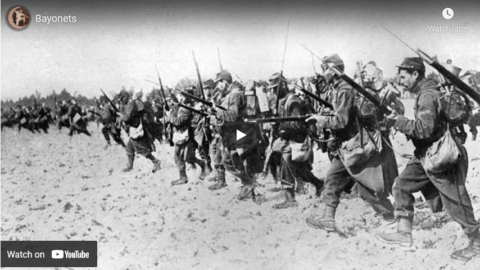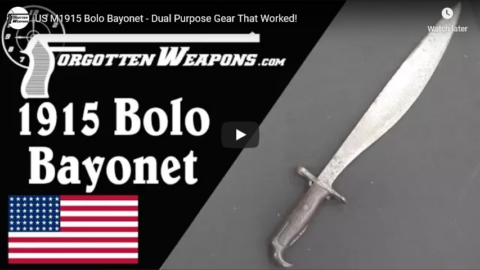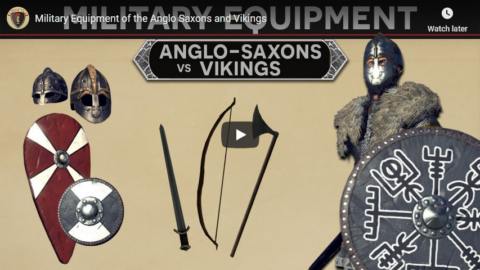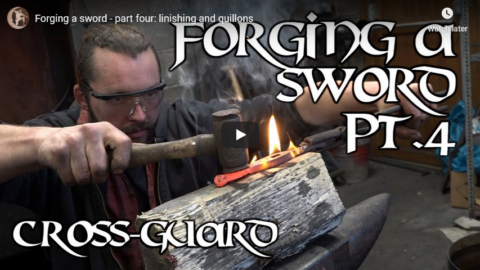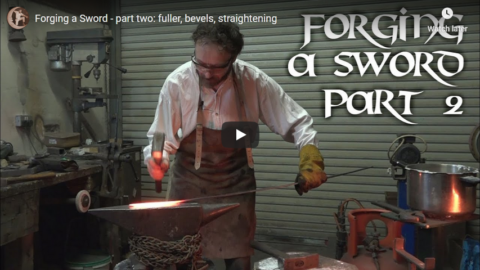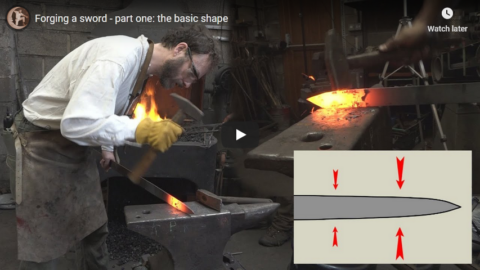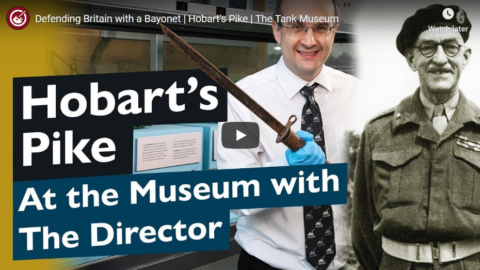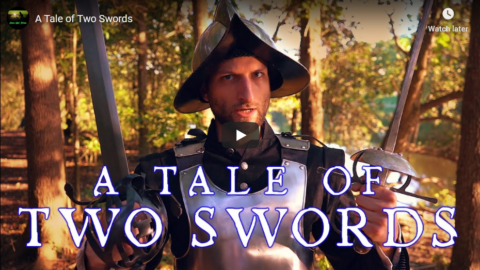Forgotten Weapons
Published 10 Feb 2021http://www.patreon.com/ForgottenWeapons
https://www.floatplane.com/channel/Fo…
Cool Forgotten Weapons merch! http://shop.bbtv.com/collections/forg…
The British entered World War One with a technically excellent rifle, with lots of bells and whistles. By 1916, the war was taking a previously unimaginable toll on the industrial capacity of the Empire and rifle production had to be economized. This led to the adoption of the MkIII* pattern of the Lee Enfield, to reduce cost and speed up production. The MkIII* omitted the windage adjustments on the rear sight, the front and rear volley sight elements, and the magazine cutoff. Around the same time, stock discs stopped being stamped with unit information (to avoid giving military intelligence of troop distribution when rifles were captured) and eventually deleted entirely.
The Pattern 1907 bayonet was also changed, although this does not coincide with the MkIII* rifle. In 1913, the British decided to delete the quillon from the standard bayonet. A great many bayonet with quillons were already in service, and those would be used in World War One, although many were modified in the field to cut off the quillons to avoid them hanging up on barbed wire or other obstacles.
Contact:
Forgotten Weapons
6281 N. Oracle #36270
Tucson, AZ 85740
May 25, 2021
Wait, Go Back! The SMLE MkIII* Wartime Simplification
May 16, 2021
Bayonets
Lindybeige
Published 26 Feb 2011A weapon can be very effective even if it never actually kills anyone.
Support me on Patreon: https://www.patreon.com/Lindybeige
Lindybeige: a channel of archaeology, ancient and medieval warfare, rants, swing dance, travelogues, evolution, and whatever else occurs to me to make.
▼ Follow me…
Twitter: https://twitter.com/Lindybeige I may have some drivel to contribute to the Twittersphere, plus you get notice of uploads.
website: www.LloydianAspects.co.uk
April 4, 2021
The Good Idea Fairy Strikes: American Trowel Bayonets
Forgotten Weapons
Published 13 Nov 2017The United States first experimented with a combination trowel and bayonet in 1868, producing 200 experimental examples made from standard socket bayonets. This was immediately followed by an additional 500 Model 1869 trowel bayonets made new. These were distributed to a few companies of the infantry to test in the field. Remarkably, the trials reports were overwhelmingly positive.
The US infantryman at that time did not carry any sort of entrenching tool, and so even an awkward combination tool was an improvement over a canteen cup or other ad hoc tool for digging. The bayonet was seen by some officers as becoming obsolete with the introduction of breechloading rifles, so the reduced effectiveness of the new item as a bayonet was not a substantial concern. The intended use of these tools was not to dig elaborate trenches, but rather to hastily construct a shallow ditch and embankment which would provide just enough cover to shelter a prone soldier.
With the trials reports in, the government purchased 10,000 of the improved 1873 pattern trowel bayonet, which featured a stronger blade and a much more comfortable handle for digging. These were issued and used in the field (and in several combat engagements), but the developmental direction turned towards combination knife trowels instead of bayonets, and there would be no further development or issue of these tools after the 1870s.
See the full trials report here: https://books.google.com/books?id=qUE…
http://www.patreon.com/ForgottenWeapons
Cool Forgotten Weapons merch! http://shop.bbtv.com/collections/forg…
If you enjoy Forgotten Weapons, check out its sister channel, InRangeTV! http://www.youtube.com/InRangeTVShow
November 16, 2020
US M1915 Bolo Bayonet – Dual Purpose Gear That Worked!
Forgotten Weapons
Published 27 Nov 2017The M1915 bolo bayonet was originally the brainchild of US Army Captain Hugh D. Wise, Quartermaster with the 9th Infantry in the Philippines. In 1902, he recommended the implement in a letter to his superior officers, noting that a bolo style of bayonet (ie, one with a widened machete-like blade) would have several advantages over the standard knife bayonet then being issued with the Krag-Jorgenson rifles the US Army was using. Specifically, the wider bayonet would be easier to recover after a thrust (he noted several instances of troopers being killed while trying to extricate their bayonets from enemies) and also (and more significantly) make an excellent and necessary bushwhacking tool in the jungle environment of the Philippines.
Wise’s idea was taken with interest and Springfield produced a series of experimental bolo bayonets, but the project ended there as the 1903 Springfield was adopted with a rod bayonet instead of a blade. Of course, the rod bayonet would be shortlived, and the blade bayonet would come back. The bolo bayonet ideas resurfaced in 1911 when a commission was formed to look into special equipment for the Philippine Scouts. After another series of experimental designs, the M1915 Bolo bayonet was formally adopted on May 22, 1915 and an order was placed for 6,000 of them to be made at Springfield Armory.
Delivery of these bayonets took place in 1915 and 1916, and they proved to be extremely popular tools with the soldiers in the Philippines. They would remain in service on the islands until World War Two, serving at last as a replacement for the M1913 cavalry saber for the 26th Cavalry.
http://www.patreon.com/ForgottenWeapons
Cool Forgotten Weapons merch! http://shop.bbtv.com/collections/forg…
If you enjoy Forgotten Weapons, check out its sister channel, InRangeTV! http://www.youtube.com/InRangeTVShow
November 10, 2020
WWI Pritchard Bayonet for the Webley Revolver
Forgotten Weapons
Published 23 Nov 2016Cool Forgotten Weapons Merch! http://shop.bbtv.com/collections/forg…
The Pritchard bayonet for the Webley revolver is one of the more photogenic and less truly practical weapons to come out of the Great War. Designed by one Captain Pritchard after he spent a year in France in 1915-1916 with the Royal Berkshire Regiment, the idea was to use the front 8 inches or so of a sword on a cast gunmetal hilt to create a bayonet mounted on a British service revolver. He first presented the idea to the Wilkinson Sword Company, but they were too busy making sabers and rifle bayonets, and suggested that having to sacrifice usable sword blades for production would make it quite the expensive endeavor.
Pritchard next took his idea to W.W. Greener, where he found a more receptive audience. Greener had a large supply of surplus French Gras bayonets, which were cheap and served as excellent donors for the Pritchard bayonets. Something like 200 were made in total — not formally adopted by the British but available for commercial sale to officers who might want them. While some may have seen service, no hard evidence has been found to prove any combat action with them.
Over the decades, a great many fake and reproduction Pritchard bayonets have been made — many times more than there are originals. As far as I can determine, this one is a legitimate original (although it may have a replacement locking lever). A few things to look for in authenticating a Pritchard are engraved patent and manufacturer marks (most reproductions have no manufacturer logo and a stamped patent number) and a quality casting. When you hold the blade and tap the handle with a hard object, it should ring bright and bell-like (which this one does).
August 31, 2020
Military Equipment of the Anglo Saxons and Vikings
Invicta
Published 19 Apr 2018Today we dive into the world of Early Medieval England to analyze the military equipment available to the warring Anglo Saxons and Vikings!
Support future documentaries: https://www.patreon.com/InvictaHistory
Twitter: https://twitter.com/InvictaHistoryDocumentary Credits:
Research: Invicta
Script: Invicta
Artwork: Osprey Publishing
Game: Total War Saga: Thrones of Britannia
Editing: Invicta
Music: Total War: Attila and Total War Battles: Kingdoms SoundtrackLiterary Sources
–Anglo-Saxon Thegn by Mark Harrison (Osprey Publishing)
–Viking Hersir 793–1066 AD by Mark Harrison (Osprey Publishing)
–Saxon, Viking and Norman by Terence Wise (Osprey Publishing)
August 25, 2020
August 22, 2020
June 23, 2020
Defending Britain with a Bayonet | Hobart’s Pike | The Tank Museum
The Tank Museum
Published 24 May 2020Director Richard Smith looks at Percy Hobart and the incredible weapon he was issued on joining the Home Guard at the start of WW2; a bayonet welded to a pole. Major General Percy Hobart commanded the 79th Armoured Division and gave the revolutionary, specialised tanks used on D-Day their nickname “Hobart’s Funnies”.
https://tankmuseumshop.org/
Support the work of The Tank Museum on Patreon: ► https://www.patreon.com/tankmuseum
Visit The Tank Museum SHOP & become a Friend: ► https://tankmuseumshop.org/Twitter: ► https://twitter.com/TankMuseum
Instagram: ► https://www.instagram.com/tankmuseum/
Tiger Tank Blog: ► http://blog.tiger-tank.com/
Tank 100 First World War Centenary Blog: ► http://tank100.com/
June 21, 2020
A Tale of Two Swords
Atun-Shei Films
Published 19 Jun 2020Myles Standish and Benjamin Church were military commanders in 17th century colonial Massachusetts who lived a generation apart. Standish came over on the Mayflower, and commanded the militia of the Plymouth Pilgrims in the 1620s; Church lived his whole life in the New World, and led the crack troops that tracked down Metacomet, sachem of the Pokanoket Wampanoag, during King Philip’s War in the 1670s. Standish carried an elegant German rapier, while Church used a simple naval cutlass. What changed? And what story can these two swords tell about the men who wielded them?
Support Atun-Shei Films on Patreon ► https://www.patreon.com/atunsheifilms
Leave a Tip via Paypal ► https://www.paypal.me/atunsheifilms (Between now and October, all donations made here will go toward the production of The Sudbury Devil, our historical feature film)
#PlymouthPilgrims #KingPhilipsWar #AmericanHistory
Watch our film ALIEN, BABY! free with Prime ► http://a.co/d/3QjqOWv
Reddit ► https://www.reddit.com/r/atunsheifilms
Twitter ► https://twitter.com/atun_shei
Instagram ► https://www.instagram.com/atunsheifilms
Merch ► https://atun-sheifilms.bandcamp.com~REFERENCES~
[1] Jeremy Dupertuis Bangs: “Myles Standish, Born Where? (2010).” Sail 1620 https://web.archive.org/web/201011301…
[2] Nathaniel Philbrick: Mayflower (2006). Penguin Books, Page 59-60
[3] “Short Men ‘Not More Aggressive'” (2007). BBC News http://news.bbc.co.uk/2/hi/uk_news/65…
[4] Charles Francis Adams: The New English Canaan of Thomas Morton (1883). The Prince Society, Page 284 https://archive.org/details/newenglis…
[5] Philbrick, Page 164
[6] Philbrick, Page 151-152
[7] Benjamin Church: Entertaining Passages Relating to King Philip’s War, Tercentenary Edition (1975). Pequot Press, Page 67-73
[8] Church, Page 75
[9] Church, Page 105-106
[10] Church, Page 108
[11] Church, Page 140
[12] Lisa Brooks: Our Beloved Kin (2018). Yale University Press, Page 322
[13] Church, Page 142
[14] Douglas Edward Leach: Flintlock and Tomahawk (1958). Parnassus Imprints, Page 231
[15] Philbrick, Page 338
[16] Church, Page 170
[17] Leach, Page 237
[18] Brooks, Page 337
September 22, 2019
Gladius VS Spatha – Why Did The Empire Abandon The Gladius?
Metatron
Published on 11 Feb 2017If the famous Gladius/rectangular Scutum combo had proven to be so effective for so many centuries why did the Late Empire Romans choose to abandon it in favour of a spatha/round shield combination? Here is what I think.
Gladius was one Latin word for sword, and is used to represent the primary sword of Ancient Roman foot soldiers.
A fully equipped Roman legionary after the reforms of Gaius Marius was armed with a shield (scutum), one or two javelins (pila), a sword (gladius), often a dagger (pugio), and, perhaps in the later Empire period, darts (plumbatae). Conventionally, soldiers threw javelins to disable the enemy’s shields and disrupt enemy formations before engaging in close combat, for which they drew the gladius. A soldier generally led with the shield and thrust with the sword. All gladius types appear to have been suitable for cutting and chopping as well as thrusting.
Gladius is a Latin masculine second declension noun. Its (nominative and vocative) plural is gladiī. However, gladius in Latin refers to any sword, not specifically the modern definition of a gladius. The word appears in literature as early as the plays of Plautus (Casina, Rudens).
Modern English words derived from gladius include gladiator (“swordsman”) and gladiolus (“little sword”, from the diminutive form of gladius), a flowering plant with sword-shaped leaves.
Gladii were two-edged for cutting and had a tapered point for stabbing during thrusting. A solid grip was provided by a knobbed hilt added on, possibly with ridges for the fingers. Blade strength was achieved by welding together strips, in which case the sword had a channel down the center, or by fashioning a single piece of high-carbon steel, rhomboidal in cross-section. The owner’s name was often engraved or punched on the blade.
August 30, 2019
Is The Roman Gladius (Sword) Really That Good?
August 21, 2019
QotD: The cult of Japanese cultural superiority
The Forged in Fire people have a new show: Knife or Die. It’s hard to discuss, because I don’t want to ridicule anyone. Any person with a desire to compete can show up with a big knife, and they will turn you loose on an obstacle course of things to cut. The first episode featured a Caucasian man wearing an Aikido costume and running shoes. I am serious. He carried a katana or “samurai sword,” even though aikido guys aren’t taught how to fight with swords. He hit a block of ice with it, and it bent in the middle.
That was a major blow to the Japan cult. Katanas are supposed to cut concrete blocks! At least that’s what they say in the Tokyo airport gift shop.
Why does aikido attract troubled people with unrealistic expectations? A high school friend of mine took up aikido. The Internet says he runs a dojo now. He gave his life to aikido. Unfortunately, aikido has a serious problem: it doesn’t work at all. Sure, you can twist people’s wrists and immobilize them if they are stupid enough to give you their hands, but everyone who has tried aikido in the ring has had his behind handed to him in individually wrapped slices. I can’t understand devoting your life to a martial art which can be defeated easily by 95% of angry untrained drunks. Would you open a store that only sold appliances that didn’t work?
Here are the words that start every single aikido demonstration: “Give me your hand.”
People are enchanted by Japan. They think the Japanese have deep wisdom we lack. They do, and here it is: do your job well and treat your elders and your boss with respect. That’s about it; the rest is hocus pocus. There are no Japanese superpowers. There is no chi. Steven Seagal has never once used magical Japanese aikido to fight a real fight because he knows he would experience humiliating losses.
Forged in Fire has its funny moments, but Knife or Die is a little too ridiculous to lampoon. It’s almost sad. It’s probably dangerous, too. Untrained eccentrics swinging razor-sharp knives of unknown quality in a timed test are a recipe for deep wounds and severe blood loss. I would hate to be in the studio when half of a knife goes flying off at 60 miles per hour.
Steve, “Knives for Knaves”, Tools of Renewal, 2018-05-31.
August 13, 2019
Hands on with the Sutton Hoo sword I Curator’s Corner Season 5 Episode 1
The British Museum
Published on 5 Aug 2019Sue Brunning and her trusty foam sword (newly dubbed Flexcalibur by commentator Pipe2DevNull) are back for another sword story. This time Sue takes us up close and personal with one of the most famous swords ever discovered.
Sue has also written a blog about Sutton Hoo available here: https://bit.ly/2yQkfYV (there are lots of other great articles there too!)
#CuratorsCorner #SwordswithSue #SuttonHooSue


